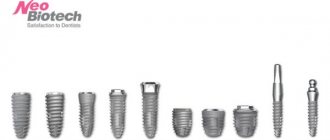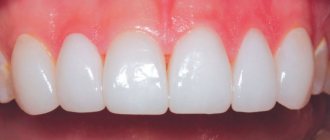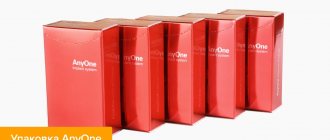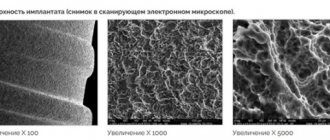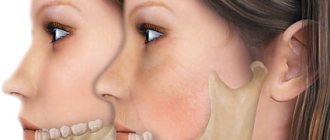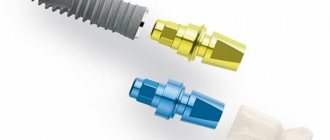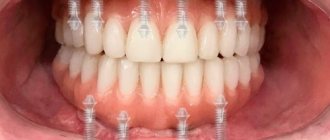In the market of dental products intended for high-quality implantation, artificial roots of the Niko brand are allocated to a special category of products.
The domestic manufacturer took care of their quality and accessibility to wide sections of the population of a multinational country. The competitiveness of Niko implants is determined not only by price, but also by some advantages of orthopedic products.
History of appearance
The correct choice of structures designed for high-quality restoration of the integrity and aesthetics of the dentition eliminates the development of complications and rejection of structures.
The Rusimplant LLC team, together with German specialists, developed the RGS “NIKO” dental implant system, which quickly gained the trust of implantologists and their patients.
Innovative developments began to be mass-produced in 2009. Niko implants are in great demand these days.
They are not inferior in performance characteristics to products from foreign manufacturers, allow high-quality orthopedic procedures and cost much less than imported designs.
The cost of Niko implants is 2-3 times lower than their foreign counterparts.
About the manufacturer and quality of dental implants
The Rusimplant company was called Niko until 2009. The production of Russian implants is based on engineering developments, materials, and ideas of the German concern Niko Dental GmbH. The systems are not inferior in quality to their European counterparts. They are manufactured using high-quality Japanese, Swiss and German equipment. Simplicity of designs ensures reliability, strength and durability.
The company has representative offices in Germany and France. Scientific developments in the field of implantology continue. The designs and materials of artificial roots are constantly being improved, the risk of rejection is minimized, and the service life is increased.
Production Features
The production of Niko systems is based on the use of high-tech equipment from Switzerland, Japan, Germany, and high-quality materials developed by leading specialists.
The team’s responsible approach to completing assigned tasks and showing concern for their compatriots allows us to create ideal supports for orthopedic structures and carry out prosthetics at a high professional level at competitive prices.
The creation of each model of the RGS “NIKO” dental construction system begins with the development of drawings of exclusive products.
The decision to use titanium, purified from impurities and inclusions of other chemical elements, as well as surgical steel as the main material for the manufacture of artificial roots, made it possible to obtain high-quality artificial roots for the installation of prostheses , biocompatible with the tissues of the oral cavity.
Sandblasting and acid etching of the surface can improve the hygiene of products. To prevent the development of bacterial pathogenic microflora, Niko implants are treated with UV rays, ensuring a high degree of sterility. Double special packaging ensures safe transportation of products to customers and a high percentage of hygiene.
Advantages of Antogir dental implants and their unique features. Read here what are the main differences between Xive implants.
Follow the link https://dr-zubov.ru/implantaciya/proizvoditeli/ankylos/universalnost-i-kachestvo-nemeckix.html if you are interested in the design of Ankylos implants.
Design Features
- Fastening using an internal hexagon guarantees a reliable connection of all elements of the implantation system and prevents their displacement.
- The tight fit of the rod to the gum prevents the destructive process of the cortical plate of the bone from activating.
- pure titanium without impurities for the production of implants eliminates the development of allergic reactions and ensures a high survival rate of the artificial tooth root.
- A rough surface accelerates the process of osseointegration.
- Gamma radiation treatment and sealed packaging guarantee complete sterility.
A set of steel surgical and orthopedic instruments from the manufacturer allows the implantation procedure to be carried out quickly, with minimal trauma.
Design features
Titanium supports for orthodontic structures are characterized by strength, reliability, and long service life.
Their intraosseous parts have a cylindrical shape. The presence of a persistent thread makes it possible to ensure uniform loads on the bone tissue.
The places where they connect to the abutment are distinguished by a hexagonal shape, which eliminates the risk of rotational movements of the body.
The use of a unique technology for processing products makes it possible to obtain a special microrelief, which increases the bioinertness and biotolerance of Niko brand implants.
The superstructures differ in length, the presence or absence of protrusions, and have a straight and inclined design. The types of superstructure determine the possibilities of the lateral or transocclusal method of fixing the supports.
When installing Niko screw implants, a classic two-stage method of implantation into bone tissue is used. The ability to fix temporary supports with straight or spherical heads for installing dentures allows you to solve aesthetic and functional problems of the oral cavity in the absence of individual teeth during the implantation procedure.
Niko rods can be used for patients with diminishing or porous bone tissue, as well as immediately after amputation of teeth.
Features of LIKO implants
Experts often suggest that patients choose LIKO products. Why do they pay special attention to them? The implant itself is an artificial root of a dental unit, which is implanted into the jaw tissue, becoming one with it. Subsequently, a corresponding crown is made for this artificial root, which is no different from a natural tooth. It is very important that the foreign body takes root in the body as quickly and efficiently as possible. Otherwise, rejection may occur, resulting in many problems for the patient. The peculiarity of LIKO implants lies in their unique shape and structure, which allows minimizing all possible negative risks of prosthetics. More details:
- Titanium base of the product. The artificial root is made from pure titanium, which is previously cleaned of all possible natural impurities. This material is very durable in its structure, adheres well to bone tissue and is rarely capable of causing an allergic reaction in the body, causing rejection of the product.
- Surface feature. The survival rate of a structure greatly depends on the characteristics of its surface. Manufacturers have noticed that the smoothness of the artificial root causes it to slide along bone tissue. It takes a long time for a structure to survive in such conditions. The situation was corrected using special chemical treatments, which made it possible to change the morphology of the titanium surface. The roughness of the surface layer increased, which had a beneficial effect on the biocompatibility of living tissues with non-viable material.
- Features of the forms. In addition to the rough surface, LIKo products have special shapes. Helical configurations of products, the presence of all kinds of depressions and irregularities. All this allows us to achieve maximum adhesion between surfaces, which contributes to their rapid and high-quality fusion, minimizing the risk of rejection of the structure.
Important: Many patients mistakenly consider titanium to be a heavy material for prosthetics. Titanium structures are comfortable to use and do not put much pressure on the jaw.
Other differences
In addition to structural features, LIKOs also have other advantageous differences. The first is the standardization of the installation scheme. The structural features of the artificial root do not require special or additional procedures for implantation of the structure.
It is also very important to take into account when choosing. The variety of types allows you to choose the appropriate implant for the most complex cases. For example, patients often turn to an implantologist a long time after losing a tooth. Bone tissue without a dental unit tends to thin out. And the longer the patient delays with prosthetics, the thinner the bone tissue becomes. Since the implant is an artificial replacement for the natural tooth root, it must be completely surrounded by bone tissue, with which it will subsequently fuse. To implant structures from other companies under these conditions, it is often necessary to perform an additional operation - a sinus lift. It involves artificial growth of bone tissue and is quite expensive. In the case of Rusimplant implants, there is no need for this operation. A large selection of designs will allow you to choose the right model that will take root perfectly without surgery to build up the necessary tissues.
Not all implants can boast the ability to perform surgery in one stage. As a rule, most structures are installed after the diseased tooth has been removed and the damaged tissue has completely healed. In the case of Rusimplant, these multi-stage moves can be avoided. The specialist preliminarily assesses the condition of the oral cavity. If there are no contraindications, the structure is installed in one step immediately after removing the remains of the diseased tooth. In this case, aesthetic problems can be avoided with the help of a temporary crown, which will be replaced with a permanent unit after the implant has completely healed. For the patient, this technology saves time and money, and doctors note the speed and convenience of this procedure.
The lineup
offers a wide range of Niko implant models. They allow the installation of artificial roots in severe clinical cases and the choice of the best options that meet the wishes and financial capabilities of patients.
Each model has a registration number, which is protection against counterfeiting and confirms the quality of the design.
Standard
Models of the “Standard” series have been successfully implanted for more than 10 years. The structures have the form of cylinders with a thrust thread of a trapezoidal shape.
A step of 0.8 mm ensures stable placement of the implant and also eliminates the risk of displacement of the product in the vertical plane.
The rounded base provides a unique opportunity to perform one-stage implantation with bone grafting.
Standard plus
Production began after improving the surface design of the commercially produced type of implants of the “Standard” series.
The improvement made it possible to use artificial roots for one- and two-stage implantation with increased softness of the bone tissue.
Review of implant models from the Baikon catalog and their purpose. In this article we will tell you when the use of basal implants is justified.
Here https://dr-zubov.ru/implantaciya/proizvoditeli/alpha-bio/kachestvennoe-vosstanovlenie-ulybki-izrailskimi.html you will find out how reasonable the price of Alpha Bio implants is.
Lux
The series is distinguished by double threads with a tooth profile in the form of isosceles triangles. Its step size on the main body of the structure is 0.75 mm.
The micro-thread on the top of the rod has a pitch of 0.25 mm. Installation is permissible regardless of the condition of the jaw bone tissue and the size of the alveolar ridge.
The unique structure of the implants meets the requirements for biochemical load and allows for high-quality orthopedic treatment . A fine thread pitch can provide a high percentage of stabilization of the rod in the bone, eliminating the risk of its destruction.
Leader
It is an improved model of the “Lux” and “Standard Plus” series implants. The cone-shaped shape of the landing rod and the dodecahedron for installing the prosthesis are distinguished by the possibility of self-sealing , which reduces the time for healing of gum incisions.
Easy insertion into the bone due to the large aggressive and fine six-start thread facilitates the installation of supports in difficult clinical cases.
Compaction of the hard tissue of the jaw occurs along the entire length of the product. The surface is processed using SLA technology.
The video provides a description of the Leader model.
Short
The Short series is used in complex clinical cases. It is characterized by its small length, the ability to eliminate the risk of damage to vital structures of the oral cavity.
Shortened rods can have a diameter of 5.5 mm and 6.0 mm, and are distinguished by a three-start aggressive thread and a beveled shoulder.
SLA technology was used for surface treatment. Design features ensure uniform load distribution on the bone and its integrity.
Small
Recommended for implantation of frontal areas against the background of a narrow alveolar ridge.
The design features include the function of combining the plug screw and the gum former , double thread, which ensures maximum stabilization in the bone and rapid adaptation to it.
Assets
Used in cases of low bone quality. Distinctive characteristics include a unique design with self-sealing properties of the internal seat body and hexagon.
The bone column that forms inside the implant ensures its reliable fixation in the hard tissues of the jaw. There are no problems with the blood supply inside it.
Learn more about the Active series from the video.
Solo
The Solo series is recommended for a one-stage implantation procedure with the installation of temporary structures.
The models guarantee a reduction in patient discomfort and recovery time after surgery. Their installation is recommended if the condition and volume of bone tissue are satisfactory in accordance with the requirements for the simultaneous implantation procedure.
Mini
The designs belong to a series of temporary models, where the outer diameter is 2.0 mm. Models with a ball-shaped head are designed for installing removable dentures.
Implants with a cone-shaped head are used to fix fixed orthopedic structures.
High-quality fixation in the tissues of the jawbone is due to the microrelief of the surface layer and the self-sealing function.
There is no risk of developing allergies or rejection. The length of the products is produced in three options: 10, 13 and 16 mm.
What are pterygoid implants?
Without a doubt, zygomatic models have taken implantology to a whole new level. But their installation is very complicated and places high demands on the training of a specialist and the equipment of dentistry. Even a minor mistake can lead to injury to the maxillary sinuses, damage to internal structures, nerve nodes, cavities, and organs of vision. In addition, implantation of a pair of Zygoma implants increases the price of prosthetics by 30-35%. Therefore, clinical studies on implantation of the upper jaw in conditions of critical bone atrophy have not stopped.
It turned out that the fixed zones of bone tissue that are not subject to destruction at any age include not only the zygomatic bone, but also the pterygoid bone. This made it possible to develop a new generation of implantation systems with minimal risk of complications during installation - pterygoid (pterygoid).
Pterygoid
(lat.) is part of the sphenoid bone of the pterygoid process, which gives its name to new models of artificial roots. Because the pterygoid process is closer, pterygoid (pterygoid) implants are shorter than zygomatic models. Their length is 15-24 mm, diameter is from 3.5 to 4.5 mm, which means:
- minimal likelihood of injuring important jaw structures when installing a titanium root;
- no risk of perforation of the maxillary sinus or damage to the orbit.
The pterygoid implant is equipped with a combined microthread with high cutting ability. A titanium root installed posteriorly in the upper jaw arch, starting from the maxillary tubercle, crosses the bone plates of the pterygoid fossa. When screwed in, the bone tissue around the artificial root is compacted, ensuring a tight fit of the surface, high primary (mechanical) and secondary (biological) stability of the implant in the jaw. The density of the pteriomaxillary (wing-maxillary) structures provides primary stability for the anchorage of the artificial root, higher than in any other part of the jaw bone.
Wing-shaped implants are developed by the Swiss company Trate AG. ROOTT P (Pterygoid) models are part of the main line of the ROOTT universal implant system. This solved the issue of sinus lift, allowing implantation to be carried out without it, even in conditions of critical maxillary bone deficiency. Because zygomatic and pterygoid models were created almost simultaneously, pterygoids are often considered a type of zygomatic implant.
Installation procedure
Implantation is a serious undertaking; it consists of a preparatory, surgical, and orthopedic stage.
It begins with performing an orthopantogram and choosing a system that takes into account the characteristics of the dentofacial apparatus, the quality and size of the bone tissue.
The subsequent algorithm of the doctor’s work includes the following actions:
- gum incision;
- bed preparation;
- installation of an implant without a supragingival part;
- placing sutures on the gums to isolate the system from the stresses that arise when chewing food;
- making a re-incision of the gum;
- installation of the former;
- creation of a bed;
- installation of abutment;
- production of a prosthesis and subsequent fixation on an artificial root.
Two to six months pass between the first and second incisions. During this period, it is forbidden to load the gums.
Cost of installation of LIKO implants
| Manufacturer: | A country: | Price: |
| LIKo | Russia | RUB 18,900 |
| The doctor's consultation | free of charge | |
| Computer examination of the jaw | free of charge | |
| Panoramic shot | free of charge | |
| Tomography of the jaw | from 1,400 rub. | |
| Installation of the healing abutment | 2,000 rub. | |
| Open sinus lift | if necessary | 40,000 rub. |
| Bone grafting (by transplantation method) | if necessary | 30,000 rub. |
| Guided bone regeneration | if necessary | 15,000 rub. |
The cost of the implant includes : initial examination, anesthesia, implant and surgery to install it.
The policy of the private clinic "Aesculapius" is aimed at providing affordable dental medicine to all residents of Moscow and the surrounding regions.
We purchase domestic Liko implants and products from other manufacturers at factory prices, which allows us to avoid unnecessary markups and provide goods at the first price in Moscow. On our clinic’s website you can view a detailed price list, which indicates the exact cost of services.
By contacting us, you can be sure that implantation or other procedures will be inexpensive, since we keep our prices for the installation of a reliable Liko implant as reasonable as possible and do not inflate them without very compelling reasons.
In addition to the direct implementation of the prosthesis, we offer a number of additional services, among which bone grafting is especially in demand. By doing procedures with us, you save time, effort and money!
Life time
Practice shows that during the period of using RGS “NIKO” dental implant systems for 5-10 years, provided that all necessary hygienic procedures were performed, no cases of their rejection or destruction were identified.
According to the results of the company's scientific tests, the maximum service life of the structures is 25 years.
Price
The catalog presents the following prices for NIKO dental implant systems.
| № | Implant series | Unit price in rubles | Turnkey service cost in rubles |
| 1. | "Standard" | 4500 | 35000–50000 |
| 2. | "Standard Plus" | 4800–5200 | 35000–50000 |
| 3. | "Lux" | 5200–5700 | 45000–60000 |
| 4. | "Leader" | 6000 | 50000–70000 |
| 5. | "Short" | 6000 | 50000–70000 |
| 6. | "Small" | 4000–4500 | 35000–50000 |
| 7. | "Assets" | 6000 | 50000–70000 |
| 8. | "Solo" | 4000–4500 | 35000–50000 |
| 9. | "Mini" | 3800–4100 | 35000–50000 |
A system of discounts applies when ordering large quantities of products, and holding promotions in dental clinics across the country allows for implantation at lower prices and saving the family budget when restoring the dental system.
Types of dental implants by material
Dentists have a unanimous opinion regarding which dental implants are better in terms of material - titanium is always the leader. This durable material is widely used in medicine, including dentistry. Nowadays it is rare to find implants made of pure titanium, and a mixture of metals is usually used, which is primarily due to their ability to take root faster. Tantalum, molybdenum and zirconium are most often present in the mixture.
Zirconium is less durable than titanium, but it takes root much more successfully and faster. If a person is allergic to titanium, and this is rare, he is usually given a zirconium implant. It costs much more, but it is the most optimal alternative in this case. They may also recommend special corundum ceramics, which is cheaper than titanium, but at the same time is significantly inferior in strength and takes less root.
How much does it cost to get a dental implant?
Types of dental implants and prices are inextricably linked, as the cost will vary depending on the option.
The following factors usually influence the final amount:
- type of implant;
- material;
- Country of Origin;
- installation cost;
- other procedures.
For example, when you contact a clinic, you are given a consultation, which is usually paid for. Since dental implantation is not included in the list of free services under compulsory medical insurance policies, you will have to pay yourself, and for all the actions of the doctor. After consultation, an x-ray is always prescribed. Next begins the preparation, implantation of the pin, installation of a temporary crown, production of a permanent one, and so on. As a result, it often turns out that the cost of the implant itself is equal to the cost of the work, so when reading the clinic’s price list, it is necessary to clarify the prices: are they indicated only for the implant or including installation work.
Approximate cost for different types of implants:
- prices for root-shaped ones start at 5,000 rubles and can reach up to 100,000 depending on the material and country of manufacture;
- for lamellar ones the maximum price is 15,000 rubles, but the cost of installation may be higher than for root-shaped ones;
- It’s difficult to name the price for combined ones, since they are usually selected on a case-by-case basis and are often made to order, but they are often in the average price range of about 15,000-20,000 rubles.
Since the price is affected by the quality of the material, you should not save. If a specialist recommends choosing a more durable implant and paying extra for it, you should weigh this proposal.
